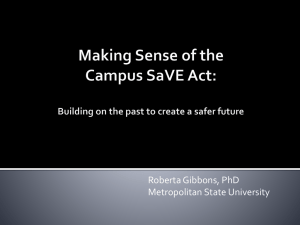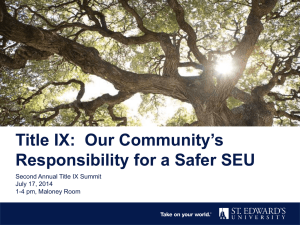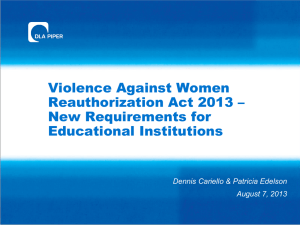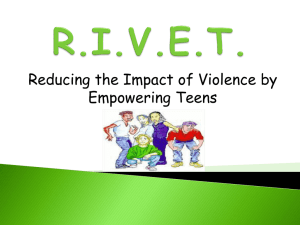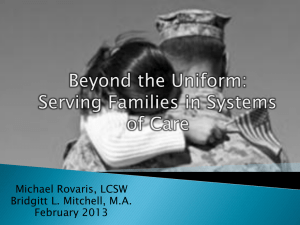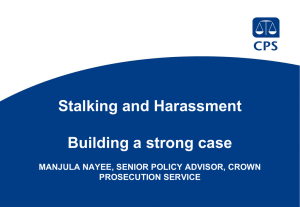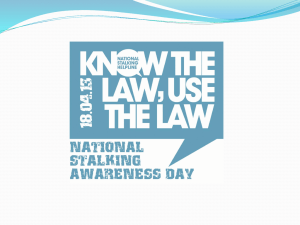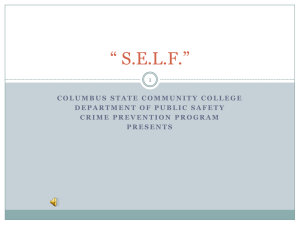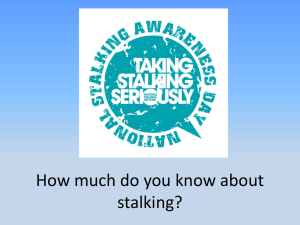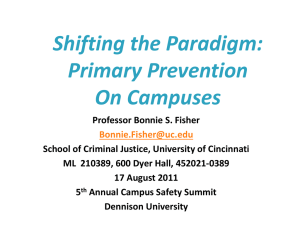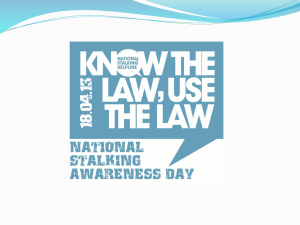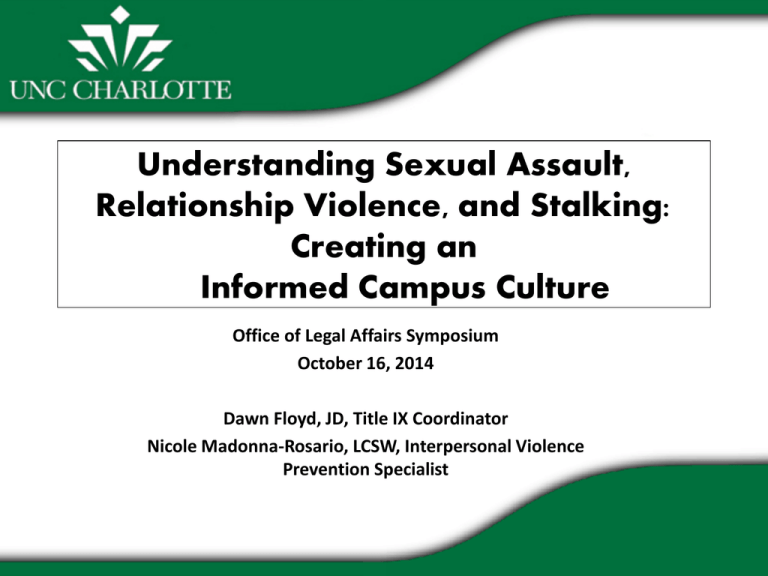
Understanding Sexual Assault,
Relationship Violence, and Stalking:
Creating an
Informed Campus Culture
Office of Legal Affairs Symposium
October 16, 2014
Dawn Floyd, JD, Title IX Coordinator
Nicole Madonna-Rosario, LCSW, Interpersonal Violence
Prevention Specialist
Its On Us – All of us!
http://itsonus.org/#videos
Stalking Statistics
• 1 in 6 women and 1 in 19 men have experienced
stalking victimization at some point during their
lifetime in which they felt very fearful or believed
that they or someone close to them would be
harmed or killed.
• The majority of stalking victims are stalked by
someone they know. 66% of female victims and 41% of
male victims of stalking are stalked by a current or
former intimate partner.
• More than half of female victims and more than 1/3
of male victims of stalking indicated that they were
stalked before the age of 25
Examples of Stalking
Stalking can take many formshere are some examples:
• Excessive phone calls
(including hang-ups) or text
messages
• “Cyberstalking”- Using social
media as a tool to monitor the
actions of the victim
• Showing up uninvited to
home, work or school
• Send unwanted gifts, letters,
emails
• Make threats to harm
you or your friends or
family
Scope of the Issue- Relationship Violence
•
•
•
•
•
•
1 in 4 women (24.3%) and 1 in 7 men (13.8%) aged 18 and older in the
United States have been the victim of severe physical violence by
an intimate partner in their lifetime.
Nearly half of all women and men in the United States have
experienced psychological aggression by an intimate partner in
their lifetime
Females ages 18 to 24 and 25 to 34 generally experienced the highest
rates of intimate partner violence.
For lesbian and bisexual women: Lesbian – 43.8% Bisexual – 61.1%
For men: Gay – 26.0% Bisexual – 37.3%
Transgender individuals are less likely to report and so the
statistics specific to them are limited. Most reports are local but
most show that the rates of violence are much higher
http://www.cdc.gov/violenceprevention/pdf/nisvs_sofindings.pdf
Relationship Violence
•
•
•
•
•
•
•
•
•
•
•
Verbal
Psychological
Emotional
Financial
Physical
Immigration status
Pet abuse
Child abuse
Contraceptive abuse
Gender privilege
Technology
The “honeymoon” phase is the
part of the cycle used to
manipulate the victim into
staying and often reminds them
of the person they originally
started dating.
Over time the abuser spends
more time in the “tension” and
“explosion” phase and the
honeymoon phase drops off.
We will see victims of dating
violence most frequently
immediately after the explosive
phase- in crisis and very
vulnerable.
The honey moon phase is one
of the reasons that it is very
difficult for victims to leave their
abusers.
Cycle Of Abuse: Copywrited in
2008 by Jill Cory & Karen
McAndless-Davis
Why all the fuss?
To address what many call the “epidemic” of
sexual violence on college campuses
One in five college women report surviving rape or
attempted rape while in college;
In 72-81% of cases in which a male rapes a female
college student, the female is intoxicated.
Between 60-90 % of victims know the accused.
Why all the fuss?
If complaints are not handled to all parties’
satisfaction or are mishandled/ignored, the
stories garner attention from the media and
from the Office of Civil Rights.
At least 70 colleges and universities are currently
under investigation by OCR
At least 30 men have filed lawsuits alleging
violations of due process and severe emotional
distress resulting from the way their cases were
handled
The Law
Title IX
• prohibits discrimination on the basis of sex
(including sexual harassment, sexual assault, and
other forms of sexual misconduct)
Campus SaVE Act/VAWA (amendment to Clery)
• provides certain notification and procedural
rights to victims of sexual assault, domestic
violence, dating violence, and stalking
Clery Act
• requires reporting of crimes (including sex
offense, domestic violence, dating violence,
and stalking) on or near campus
Code of Student
Responsibility
• Sexual harassment = unwelcome, gender-based verbal or physical
conduct of a sexual nature that is based on a power differential
• Sexual assault = sexual act (intercourse or oral sex) or sexual contact
(touching of intimate parts) without consent
• Sexual exhibitionism = engaging in sex or exposing one’s intimate parts
(buttocks, genitalia, groin, breast (unless breastfeeding)) in the presence
of others.
• Sexual exploitation = (e.g. non-consensual explicit photographs,
prostituting someone, voyeurism)
• Stalking = two or more acts directed at a specific person that would
cause a reasonable person to (a) fear for his or her safety or (b) suffer
substantial emotional distress
• Relationship violence = dating violence or domestic violence
What is Rape Culture?
Rape Culture is when we have become desensitized
to rape and sexual assault because these acts have
become normalized through media and other
imagery.
Lets Break it Down
• We understand the word CULTURE to be
related to things that members of a
society do together like education, the
arts and practicing good table manners
• Of course we understand that in general
our culture does not outwardly promote
sexual violence (although there are
some cultures that do)
• So…where does the word RAPE fit in?
Break it Down Further
• Rape culture refers to the cultural practices that a
society has in place that further perpetuate certain
gender norms and social “rules” of behavior
• These practices tend to excuse and even tolerate
sexually violent acts
• Its about how we think as a group about rape
• More often than not, it’s situations in which sexual
assault, rape, and general violence are ignored,
trivialized, normalized, or made into jokes.
Some Examples
•
•
•
•
•
•
•
•
•
•
•
•
•
•
•
Blaming the victim (“She asked for it!”)
Trivializing sexual assault (“Boys will be boys!”)
Sexually explicit jokes
Tolerance of sexual harassment
Inflating false rape report statistics
Publicly scrutinizing a victim’s dress, mental state, motives, and history
Gratuitous gendered violence in movies and television
Defining “manhood” as dominant and sexually aggressive
Defining “womanhood” as submissive and sexually passive
Pressure on men to “score”
Pressure on women to not appear “cold”
Assuming only promiscuous women get raped
Assuming that men don’t get raped or that only “weak” men get raped
Refusing to take rape accusations seriously
Teaching women to avoid getting raped instead of teaching men not to
rape
Barriers to
Reporting
•
•
•
•
•
•
•
•
•
Many victims know their
perpetrator
Fear of not being
believed (“slut-shaming”,
victim blaming)
Fear of police or medical
procedures
Fear of discrimination or
prejudice
fear of retaliation
Assumption of
heterosexuality and/or
fear of being “outed”
Shame, guilt,
embarrassment
Financial dependence on
the perpetrator
Family member
committed the assault
Title IX
Responsible Employee = any employee . . .
• who has the authority to take action to redress
sexual violence;
• who has been given the duty of reporting incidents
of sexual violence or any other misconduct by
students to the Title IX Coordinator or other
appropriate school designee; or
• whom a student could reasonably believe has this
authority or duty
Title IX
Responsible Employee =
• all Cabinet members
• all faculty members
• Police & Public Safety
• Human Resources
• Dean of Students office
• Coaches, trainers
• Housing staff, RAs, RCs
• security personnel
• Teaching Assistants
• certain PaTS staff
• Staff with supervisory
responsibilities
Confidential Resources at UNC Charlotte:
• Student Health Center
• Counseling Center
• Center for Wellness Promotion
Confidential Resources can keep reports from students
confidential and reports will not initiate an investigation by
Police and Public Safety or the Title IX Office
Go to:
incidentreport.uncc.edu
Another reporting option
•
•
•
Title IX Coordinator, Dawn Floyd – 704-687-6130
Title IX Deputy Coordinator for Academic Affairs, Katherine Hall-Hertel
– 704-687-5661
Title IX Deputy Coordinator for Human Resources, Jeanne Madorin –
704-687-0659
•
Title IX Deputy Coordinator for Students, Christine Reed Davis – 704-
687-0345
•
Title IX Deputy Coordinator for Athletics, Kim Whitestone – 704-687-
4955
Overview of complaint
resolution process
•
•
•
•
•
•
•
•
•
University learns of a complaint of sexual assault, domestic violence, dating
violence or stalking;
Assistant Dean of Students meets with Complainant and Respondent (if victim
doesn’t request confidentiality) to discuss resources, accommodations and explain
Title IX process;
Title IX Investigator talks with Complainant about his/her wishes in the Title IX
process;
Title IX Investigator conducts investigation and submits report to Office of Student
Conduct;
Office of Student Conduct determines if the Code of Student Responsibility has been
violated and, if so, determines the appropriate sanction;
Complainant or Respondent can reject findings or sanctions;
Case is heard by a hearing panel comprised of faculty and staff;
Decision of hearing panel communicated to both parties;
Parties can appeal
Title IX Priorities and Initiatives 2014-2015
Nine for IX
1. Write and/or revise campus-wide policies and protocols for handling
reports of sexual misconduct, relationship violence and stalking
2. Fair, impartial and equitable handling of all reports of sexual
misconduct, relationship violence and stalking
3. Coordinate with the Interpersonal Violence Specialist to provide
awareness and training programs to campus community members,
including bystander training
4. Implement on-line educational module for all incoming students
called Think About It that educates students on alcohol, drugs
and sexual assault in compliance with VAWA
Title IX Priorities and Initiatives 2014-2015
Nine for IX
5. Publication of Interpersonal Violence Policy and Resource Guide
for victims of sexual misconduct, relationship violence and
stalking
6. Develop campus climate survey to be completed by students in
spring 2015
7. Develop structure of Title IX Office and campus-wide Title IX
Committee
8. Coordinate Title IX activities across campus
9. Ensure compliance with all applicable laws


